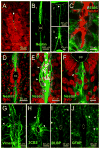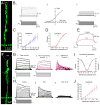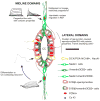Spatial domains of progenitor-like cells and functional complexity of a stem cell niche in the neonatal rat spinal cord
- PMID: 22821702
- PMCID: PMC3426862
- DOI: 10.1002/stem.1175
Spatial domains of progenitor-like cells and functional complexity of a stem cell niche in the neonatal rat spinal cord
Abstract
During spinal cord development, progenitors in the neural tube are arranged within spatial domains that generate specific cell types. The ependyma of the postnatal spinal cord seems to retain cells with properties of the primitive neural stem cells, some of which are able to react to injury with active proliferation. However, the functional complexity and organization of this stem cell niche in mammals remains poorly understood. Here, we combined immunohistochemistry for cell-specific markers with patch-clamp recordings to test the hypothesis that the ependyma of the neonatal rat spinal cord contains progenitor-like cells functionally segregated within specific domains. Cells on the lateral aspects of the ependyma combined morphological and molecular traits of ependymocytes and radial glia (RG) expressing S100β and vimentin, displayed passive membrane properties and were electrically coupled via Cx43. Cells contacting the ventral and dorsal poles expressed the neural stem cell markers nestin and/or vimentin, had the typical morphology of RG, and appeared uncoupled displaying various combinations of K(+) and Ca(2+) voltage-gated currents. Although progenitor-like cells were mitotically active around the entire ependyma, the proliferative capacity seemed higher on lateral domains. Our findings represent the first evidence that the ependyma of the rat harbors progenitor-like cells with heterogeneous electrophysiological phenotypes organized in spatial domains. The manipulation of specific functional properties in the heterogeneous population of progenitor-like cells contacting the ependyma may in future help to regulate their behavior and lineage potential, providing the cell types required for the endogenous repair of the injured spinal cord.
Copyright © 2012 AlphaMed Press.
Conflict of interest statement
The authors declare no conflicts of interests.
Figures







Similar articles
-
Purinergic signalling in a latent stem cell niche of the rat spinal cord.Purinergic Signal. 2016 Jun;12(2):331-41. doi: 10.1007/s11302-016-9507-6. Epub 2016 Mar 17. Purinergic Signal. 2016. PMID: 26988236 Free PMC article.
-
Connexin Signaling Is Involved in the Reactivation of a Latent Stem Cell Niche after Spinal Cord Injury.J Neurosci. 2020 Mar 11;40(11):2246-2258. doi: 10.1523/JNEUROSCI.2056-19.2020. Epub 2020 Jan 30. J Neurosci. 2020. PMID: 32001613 Free PMC article.
-
Enigmatic central canal contacting cells: immature neurons in "standby mode"?J Neurosci. 2009 Aug 12;29(32):10010-24. doi: 10.1523/JNEUROSCI.6183-08.2009. J Neurosci. 2009. PMID: 19675235 Free PMC article.
-
Spinal Cord Stem Cells In Their Microenvironment: The Ependyma as a Stem Cell Niche.Adv Exp Med Biol. 2017;1041:55-79. doi: 10.1007/978-3-319-69194-7_5. Adv Exp Med Biol. 2017. PMID: 29204829 Review.
-
Progenitors in the Ependyma of the Spinal Cord: A Potential Resource for Self-Repair After Injury.Adv Exp Med Biol. 2017;1015:241-264. doi: 10.1007/978-3-319-62817-2_13. Adv Exp Med Biol. 2017. PMID: 29080030 Review.
Cited by
-
Molars to Medicine: A Focused Review on the Pre-Clinical Investigation and Treatment of Secondary Degeneration following Spinal Cord Injury Using Dental Stem Cells.Cells. 2024 May 10;13(10):817. doi: 10.3390/cells13100817. Cells. 2024. PMID: 38786039 Free PMC article. Review.
-
Purinergic signalling in a latent stem cell niche of the rat spinal cord.Purinergic Signal. 2016 Jun;12(2):331-41. doi: 10.1007/s11302-016-9507-6. Epub 2016 Mar 17. Purinergic Signal. 2016. PMID: 26988236 Free PMC article.
-
Stem Cell Therapy for Spinal Cord Injury.Cell Transplant. 2021 Jan-Dec;30:963689721989266. doi: 10.1177/0963689721989266. Cell Transplant. 2021. PMID: 33559479 Free PMC article.
-
The combined application of stem cells and three-dimensional bioprinting scaffolds for the repair of spinal cord injury.Neural Regen Res. 2024 Aug 1;19(8):1751-1758. doi: 10.4103/1673-5374.385842. Epub 2023 Sep 22. Neural Regen Res. 2024. PMID: 38103241 Free PMC article.
-
Valproic Acid Arrests Proliferation but Promotes Neuronal Differentiation of Adult Spinal NSPCs from SCI Rats.Neurochem Res. 2015 Jul;40(7):1472-86. doi: 10.1007/s11064-015-1618-x. Epub 2015 May 29. Neurochem Res. 2015. PMID: 26023063
References
-
- Ming GL, Song H. Adult neurogenesis in the mammalian central nervous system. Annu Rev Neurosci. 2005;28:223–250. - PubMed
-
- Lledo PM, Alonso M, Grubb MS. Adult neurogenesis and functional plasticity in neuronal circuits. Nat Rev Neurosci. 2006;7:179–193. - PubMed
-
- Hugnot JP, Franzen R. The spinal cord ependymal region: a stem cell niche in the caudal central nervous system. Front Biosci. 2011;16:1044–1059. - PubMed
Publication types
MeSH terms
Substances
Grants and funding
LinkOut - more resources
Full Text Sources
Medical
Miscellaneous

